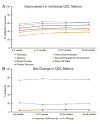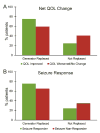Quality-of-life metrics with vagus nerve stimulation for epilepsy from provider survey data
- PMID: 27974275
- PMCID: PMC5258831
- DOI: 10.1016/j.yebeh.2016.10.005
Quality-of-life metrics with vagus nerve stimulation for epilepsy from provider survey data
Abstract
Objective: Drug-resistant epilepsy is a devastating disorder associated with diminished quality of life (QOL). Surgical resection leads to seizure freedom and improved QOL in many epilepsy patients, but not all individuals are candidates for resection. In these cases, neuromodulation-based therapies such as vagus nerve stimulation (VNS) are often used, but most VNS studies focus exclusively on reduction of seizure frequency. QOL changes and predictors with VNS remain poorly understood.
Method: Using the VNS Therapy Patient Outcome Registry, we examined 7 metrics related to QOL after VNS for epilepsy in over 5000 patients (including over 3000 with ≥12months follow-up), as subjectively assessed by treating physicians. Trends and predictors of QOL changes were examined and related to post-operative seizure outcome and likelihood of VNS generator replacement.
Results: After VNS therapy, physicians reported patient improvement in alertness (58-63%, range over follow-up period), post-ictal state (55-62%), cluster seizures (48-56%), mood change (43-49%), verbal communication (38-45%), school/professional achievements (29-39%), and memory (29-38%). Predictors of net QOL improvement included shorter time to implant (odds ratio [OR], 1.3; 95% confidence interval [CI], 1.1-1.6), generalized seizure type (OR, 1.2; 95% CI, 1.0-1.4), female gender (OR, 1.2; 95% CI, 1.0-1.4), and Caucasian ethnicity (OR, 1.3; 95% CI, 1.0-1.5). No significant trends were observed over time. Patients with net QOL improvement were more likely to have favorable seizure outcomes (chi square [χ2]=148.1, p<0.001) and more likely to undergo VNS generator replacement (χ2=68.9, p<0.001) than those with worsened/unchanged QOL.
Significance: VNS for drug-resistant epilepsy is associated with improvement on various QOL metrics subjectively rated by physicians. QOL improvement is associated with favorable seizure outcome and a higher likelihood of generator replacement, suggesting satisfaction with therapy. It is important to consider QOL metrics in neuromodulation for epilepsy, given the deleterious effects of seizures on patient QOL.
Keywords: Epilepsy; Quality of life; Surgery; VNS; Vagus nerve stimulation.
Copyright © 2016 The Authors. Published by Elsevier Inc. All rights reserved.
Conflict of interest statement
of conflicts of interest: KH in an employee of Lilanova, the manufacturer of VNS therapy and sponsor of the VNS therapy Patient Outcome Registry. The other authors have no conflicts of interest to disclose.
Figures



Similar articles
-
One-year seizure freedom and quality of life in patients with drug-resistant epilepsy receiving adjunctive vagus nerve stimulation in Japan.Epilepsia Open. 2024 Dec;9(6):2154-2163. doi: 10.1002/epi4.13025. Epub 2024 Sep 10. Epilepsia Open. 2024. PMID: 39256937 Free PMC article.
-
Outcome of vagus nerve stimulation for drug-resistant epilepsy: the first three years of a prospective Japanese registry.Epileptic Disord. 2017 Sep 1;19(3):327-338. doi: 10.1684/epd.2017.0929. Epileptic Disord. 2017. PMID: 28832004
-
Vagus nerve stimulation for drug-resistant epilepsy: a European long-term study up to 24 months in 347 children.Epilepsia. 2014 Oct;55(10):1576-84. doi: 10.1111/epi.12762. Epub 2014 Sep 17. Epilepsia. 2014. PMID: 25231724
-
Rates and Predictors of Seizure Freedom With Vagus Nerve Stimulation for Intractable Epilepsy.Neurosurgery. 2016 Sep;79(3):345-53. doi: 10.1227/NEU.0000000000001165. Neurosurgery. 2016. PMID: 26645965 Free PMC article.
-
Vagus nerve stimulation (VNS) therapy update.Epilepsy Behav. 2018 Nov;88S:2-10. doi: 10.1016/j.yebeh.2018.06.032. Epub 2018 Jul 13. Epilepsy Behav. 2018. PMID: 30017839 Review.
Cited by
-
Vagus Nerve Stimulation Therapy in Epilepsy: An Overview of Technical and Surgical Method, Patient Selection, and Treatment Outcomes.Brain Sci. 2024 Jul 2;14(7):675. doi: 10.3390/brainsci14070675. Brain Sci. 2024. PMID: 39061416 Free PMC article. Review.
-
Applications of magnetic resonance-guided laser interstitial thermal therapy in disconnective epilepsy surgery.Front Neurol. 2024 Dec 2;15:1484263. doi: 10.3389/fneur.2024.1484263. eCollection 2024. Front Neurol. 2024. PMID: 39687405 Free PMC article. Review.
-
Estimated EEG functional connectivity and aperiodic component induced by vagal nerve stimulation in patients with drug-resistant epilepsy.Front Neurol. 2022 Nov 23;13:1030118. doi: 10.3389/fneur.2022.1030118. eCollection 2022. Front Neurol. 2022. PMID: 36504670 Free PMC article.
-
Reduction of generalized tonic-clonic seizures following vagus nerve stimulation therapy: CORE-VNS Study 24-month follow-up.Epilepsia. 2025 Jul;66(7):2307-2314. doi: 10.1111/epi.18371. Epub 2025 Apr 1. Epilepsia. 2025. PMID: 40167365 Free PMC article.
-
Neurostimulation treatments for epilepsy: Deep brain stimulation, responsive neurostimulation and vagus nerve stimulation.Neurotherapeutics. 2024 Apr;21(3):e00308. doi: 10.1016/j.neurot.2023.e00308. Epub 2024 Jan 4. Neurotherapeutics. 2024. PMID: 38177025 Free PMC article. Review.
References
-
- Wiebe S, Blume WT, Girvin JP, Eliasziw M. A randomized, controlled trial of surgery for temporal-lobe epilepsy. N Engl J Med. 2001;345:311–8. - PubMed
-
- Jette N, Engel J., Jr Refractory epilepsy is a life-threatening disease: Lest we forget. Neurology. 2016 - PubMed
-
- Helmstaedter C, Kockelmann E. Cognitive outcomes in patients with chronic temporal lobe epilepsy. Epilepsia. 2006;47(Suppl 2):96–8. - PubMed
MeSH terms
Grants and funding
LinkOut - more resources
Full Text Sources
Other Literature Sources

